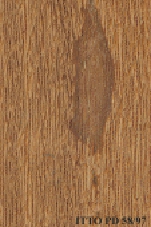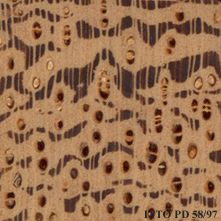
ANGELIM (Hymenolobium petraeum)
Trade Name
Angelim
Scientific Name
Hymenolobium petraeum Ducke
Family
LEGUMINOSAE
Common Names
Murarema (Brazil); Mirarema (Brazil); Angelim-Rosa (Brazil); Angelim-Pedra (Brazil); Angelim-Macho (Brazil); Angelim-Ferro (Brazil); Angelim-Comum (Brazil); Angelim-Branco (Brazil); Angelim-Aroeira (Brazil); Angelim (Brazil); Alcornoco
Description Of The Tree
Botanical Description
It is a very large unarmed tree, sometimes 40 or 50 m in height and diameters of 80 to 100 cm, occasionally over 200 cm. It develops a straight and cylindrical bole up to 25 m long, with thick buttresses up to 2 m tall.
Natural Habitat
Hymenolobium petraeum is a dominant tree found in the canopy of terra firme forests in the tropical rain forests of northern South America. It is reported to prefer dry areas.
Natural Distribution
In Brazil it is reported in Amazonas, Para, Amapa and Roraima.
Non Timber Uses
Fairly often oily or waxen patches can be observed.
Wood Identification
Anatomic Description Of Wood
Wood diffuse porous. Vessels solitary and in short radial multiples. Tangential diameter of vessel lumina 200 micras or more (large). Vessels per mm2 less than 6 (rare). Simple perforation plates. Vessel-ray pits similar to intervessel pits in size and shape. O Axial parenchyma apparent with the naked eye. Occasionally axial parenchyma in marginal or in seemingly marginal bands. Axial parenchyma confluent. Axial parenchyma in discontinuous tangential lines. Axial parenchyma in thick bands. Axial parenchyma storied. Pr 4 to 10 rays per mm (medium). Occasionally rays and/or axial elements irregularly storied. Rays storied. Rays 1 to 4 seriate. Body ray cells procumbent with one row of upright and/or square marginal cells (Kribs-III). Fibers with simple to minutely bordered pits.
-
 Wood Macro Photo Tangential Plane
Wood Macro Photo Tangential Plane
-
 Wood Micro Photo Of Transversal Section
Wood Micro Photo Of Transversal Section
Availability
Cites Status
Unrestricted
General Wood Description
Odor
It has no distinct odor or taste.
Color
The heartwood is light pink or dark gray with lighter color stripes.
COLOR INDEX (1=Black, 7=Light yellow,white)
5
Grain
Interlocked grain is reported in this species.
Texture
This wood has a somewhat coarse texture.
Luster
The wood is described as low in luster.
Natural Durability
It is resistant against fungi and dry wood insects, but it is rated as moderately resistant against marine borers.
Natural durability index (1= Very high durability, 7=Vey low durability)
2
Resistance To Impregnation
The sapwood is permeable, but the heartwood is difficult to preserve either with oil or water soluble preservatives.
Wood Physical Properties
Basic Density or Specific Gravity (O.D. weight/vol. green) (g/cm³)
0.59
Air-dry Density (Weight and volume at 12%MC) (g/cm³)
0.65
Total shrinkage Tangential (Saturated to 0%MC) (%)
6.3
Total shrinkage Radial (Saturated to 0%MC) (%)
4.1
Drying Defects
Ease of Drying: Drying is fairly slow. Drying Defects: Risk of checking and casehardening is reported.
Dimensional stability ratio (Total Tangential Shrinkage %/Total Radial Shrinkage %)
1.5
Wood Chemical Properties
Wood Mechanical Properties
Bending Strength (MOR),12%MC (kgf/cm²)
1115
Stiffness (MOE) 12%MC (kgf/cm²)
118000
Compression parallel to fiber 12%MC (kgf/cm²)
533
Compression perpendicular to fiber 12%MC (kgf/cm²)
115
Shear strength radial 12%MC (kgf/cm²)
125
Janka hardness (side) 12%MC (kgf)
781
Janka hardness (end grain) 12%MC (kgf)
590
Workability
Sawing
Sawmilling of this species is reportedly difficult.
Rotary Veneer Cutting
This species is reported to be interesting for decorative veneer.
Sliced Veneer
This species is reported to be interesting for decorative veneer.
Blunting Effect
The blunting effect is rated as negligible.
Machining
Machining of this species is reported to be difficult.
Turning
30
Nailing
Hymenolobium has a good holding of nails, but risks of split on end grain are reported.
Gluing
The timber is reported to glue well.
Finishing
It has a good finishing.
REFERENCED USES
End Uses Summary
EXTERIOR GENERAL, crossties, HOUSING GENERAL, beams, joists, boards, flooring, frames, steps, FURNITURE AND CABINETS, common furniture, PLYWOOD AND VENEER, Decorative veneer, TURNING, ornaments, turned furniture, cutlery, TOOLS, tool handles, agricultural tools, PACKING, heavy packing, pallets, NAVAL CONSTRUCTION, boat hulls, boat fins, boat deck
Exterior General
- 1 - Tabela de resultados de ensaios fisicos e mecanicos
Crossties
- 8 - Maderas latinoamericas. III, Podocarpus standleyi ,Podocarpus oleifolius, Drims granadensis, Magnolia poasana y Didymopanax pittieri
General Housing
- 10 - Silica in Timbers
Beams
- 11 - Prospect: The wood database
Joists
- 12 - Tropical timbers of the world. Part I-Tropical American Species
Boards
- 13 - Dry kiln schedules for commercial woods. Temperate and tropical. Section III. Latin American (Mexico, Central, and South America) Woods–Conventional Temperatures
Flooring
- 14 - Handbook of Hardwoods
Frames
- 16 - Woods of the World
Steps
- 17 - Tree Conservation Database
Furniture Cabinets
- 21 - Tropical timbers of the world. Part III-Southeast Asian and Oceanian Species.
Furniture, Common
- 23 - Handbook of Hardwoods
Panels, Veneers
- 25 - Directory of Timber Trade Malaysia
Decorative veneer
- 28 - Ministry of Agriculture, Fisheries & Forest of Fiji
Turning
- 30 - Embassy of Honduras in Japan
Ornaments
- 31 - Embassy of Colombia in Japan
Turned Articles
- 32 - Embassy of Cote d`Ivoire in Japan
Knife Handles
- 33 - Embassy of Gabon in Japan
Tools
- 42 - Utilización Industrial de Nuevas Especies Forestales en el Perú.
Tool Handles
- 43 - Maderas de Bolivia (Características y Usos de 55 Maderas Tropicales)
Agricultural Tools
- 44 - Atlas of Peruvian Woods
Packing
- 45 - Recopilación y Análisis de Estudios Tecnológicos de Maderas Peruanas
Heavy Packing
- 47 - Arvores Brasileiras
Pallets
- 48 - The strength properties of timbers
Shipbuilding
- 55 - Tropical Timber Atlas of Latin America
Boat Hulls
- 57 - Estadísticas de Aprovechamiento, Exportación y comercialización Nacional de Productos Forestales
Boat Fins
- 58 - Guía de Árboles de Bolivia
Boat Decking
- 59 - Programa Nacional de uso Sostenible de los Bosques e Incremento a las Exportaciones.
Please Provide Information To View Producer Information